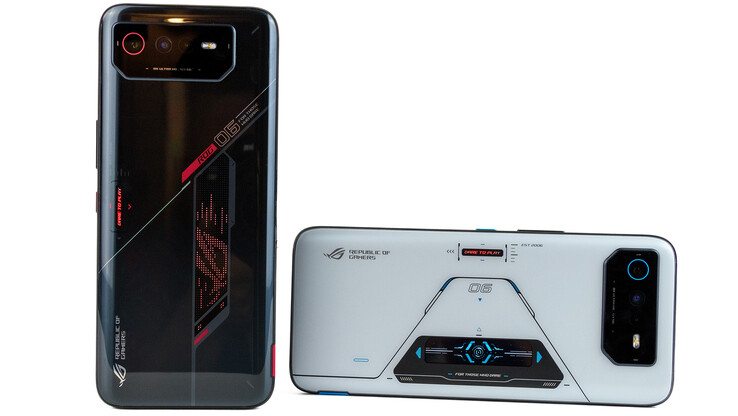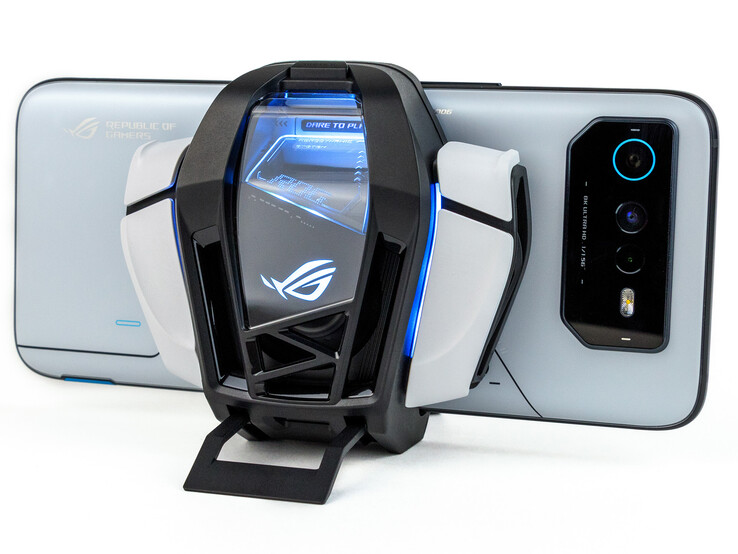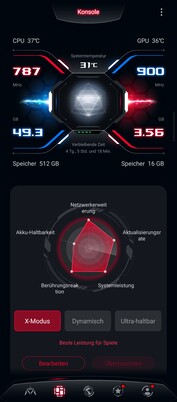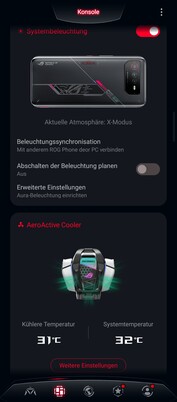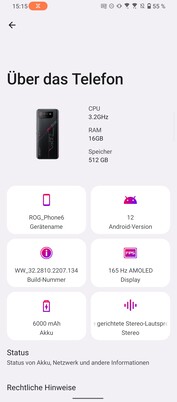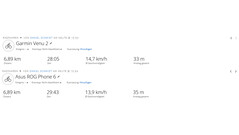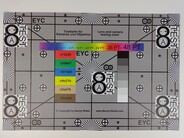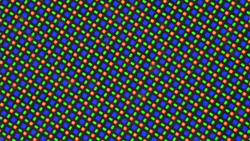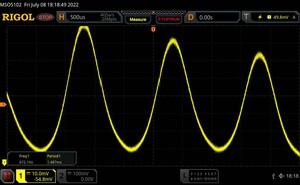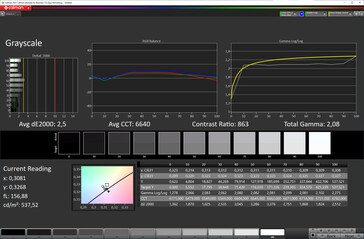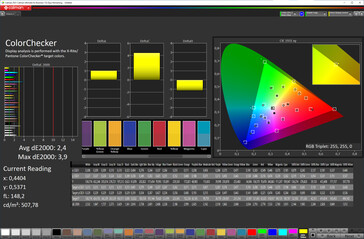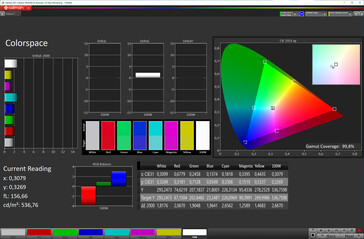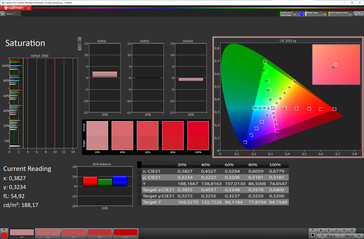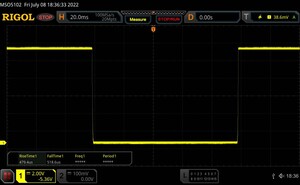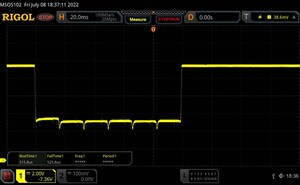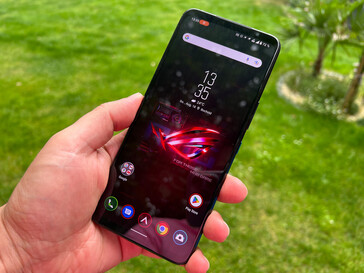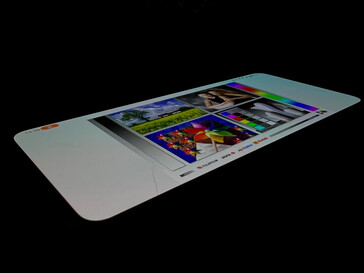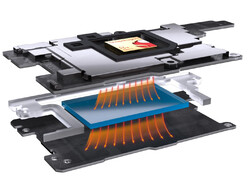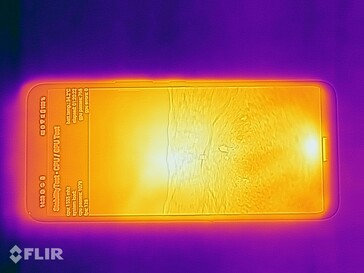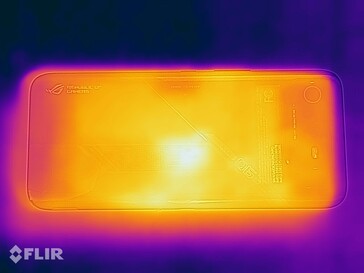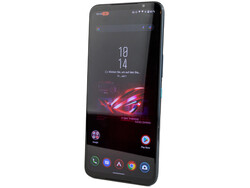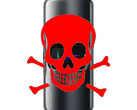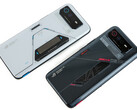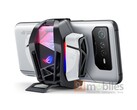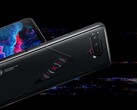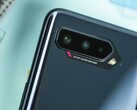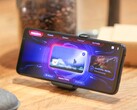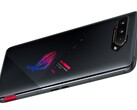Asus ROG Phone 6 and 6 Pro review - Probably the best gaming smartphone
This year, Asus skips the S model and has equipped its gaming smartphone directly with the pimped up model of Qualcomm's top SoC. A good decision, since that has a reputation of not only being slightly more powerful but also significantly more efficient.
In addition to the new chip set, the display is also improved, offering a higher refresh rate as well as improved touch sensitivity. Furthermore, the Asus ROG Phone 6 (Pro) now uses a modern Sony IMX766 image sensor that is also used in other flagship smartphones of 2022.
Possible Competitors in Comparison
Rating | Date | Model | Weight | Drive | Size | Resolution | Price |
|---|---|---|---|---|---|---|---|
| 89.5 % v7 (old) | 01 / 2023 | Asus ROG Phone 6 Pro SD 8+ Gen 1, Adreno 730 | 239 g | 512 GB UFS 3.1 Flash | 6.78" | 2448x1080 | |
| 88.7 % v7 (old) | 12 / 2021 | Asus ROG Phone 5s SD 888+ 5G, Adreno 660 | 238 g | 512 GB UFS 3.1 Flash | 6.78" | 2448x1080 | |
| 85.7 % v7 (old) | 06 / 2022 | Xiaomi Black Shark 5 Pro SD 8 Gen 1, Adreno 730 | 220 g | 256 GB UFS 3.1 Flash | 6.67" | 2400x1080 | |
| 85 % v7 (old) | 03 / 2022 | Nubia RedMagic 7 SD 8 Gen 1, Adreno 730 | 226 g | 256 GB UFS 3.1 Flash | 6.80" | 2400x1080 |
Case - ROG phone with Gorilla Glass Victus
The two Asus ROG Phone 6 models look very similar to their predecessors and can be recognized immediately as gaming smartphones. The standard and the Pro model differentiate themselves particularly with their displays on the back, which now offer 60 new animations. While the standard model has an RGB matrix, the Pro model offers a PMOLED display. The standard model is available in black (Phantom Black) and white (Storm White) versions, and the ROG Phone 6 Pro only in white.
The workmanship of both smartphones is very good, and any gaps between the materials are very tight and even. The case doesn't respond to any attempts of warping and doesn't produce creaking noises. Our only minor point of complaint might be the display-to-surface ratio of 82%, although the slightly thicker bezels on the short sides could be quite practical when the ROG Phone is held in landscape format, and the bezels also house the two front speakers. In addition, the ROG Phone is no lightweight at 239 grams (~8.4 oz).
While the back is protected by Corning Gorilla Glass 3, the display uses the modern Victus glass. Although the IPX4 certification demonstrates protection from splashes for all the sides, the smartphones of the ROG Phone 6 series are not waterproof. The card tray is made of plastic and can take up two Nano-SIM cards.
Equipment - Smartphone with two USB ports
In terms of equipment, Asus hardly changed anything from the ROG Phone 5s but only removed the additional touch sensors on the back. The AirTrigger ultrasound sensors are now included in the sixth generation and can again be configured using the X mode. They serve as additional input keys while gaming and support tapping, swiping, and pushing gestures.
The USB 2.0 port at the bottom edge is primarily meant for charging of the smartphone. The port on the long side works according to the specifications for USB 3.2 (Gen. 2), not only supporting high data transfer rates and fast charging according to the PD 3.0 or QuickCharge 5.0 standards, but also wired display output in Ultra HD resolution.
Software - Only two years of updates for the ROG Phone 6 Pro
The Asus ROG Phone 6 and 6 Pro are delivered with Google Android 12 and the ROG UI. Asus doesn't preinstall a lot of third-party software, but mainly only a few apps by Meta and Netflix. An important part is the X mode, allowing you to configure many components of the smartphone such as the AirTriggers, illumination, and the optional AeroCooler.
During our test period, the ROG Phones were regularly provided with updates that also always contained a few smaller optimizations. Unfortunately the period in which updates will be provided is relatively short with only two years.
Communication and GNSS - Powerful in the WLAN and locating itself
The Asus ROG Phone 6 supports all the modern communication standards. For mobile communication, this means 5G-Sub6 with a wide frequency band coverage in the best case. The Pro model supports a few additional bands and allows slightly higher transfer rates in the LTE and 5G networks. At least, this is the case in theory, since in practice, the high values of up to 4.5 and 4.9 Gbit/s will probably still remain unachievable in the near future.
In the WLAN, the gaming smartphone is absolutely convincing in combination with our Asus ROG Rapture GT-AXE11000 reference router, achieving stable and high transfer rates in the 5-GHz as well as the 6-GHz networks. In addition, it also supports dual-Wi-Fi and is therefore even able to connect to two networks at the same time.
| Networking | |
| Asus ROG Phone 6 Pro | |
| iperf3 receive AXE11000 | |
| iperf3 transmit AXE11000 | |
| iperf3 transmit AXE11000 6GHz | |
| iperf3 receive AXE11000 6GHz | |
| Asus ROG Phone 5s | |
| iperf3 transmit AX12 | |
| iperf3 receive AX12 | |
| Xiaomi Black Shark 5 Pro | |
| iperf3 transmit AXE11000 6GHz | |
| iperf3 receive AXE11000 6GHz | |
| Nubia RedMagic 7 | |
| iperf3 receive AXE11000 | |
| iperf3 transmit AXE11000 | |
| Average of class Smartphone | |
| iperf3 receive AXE11000 | |
| iperf3 transmit AXE11000 | |
| iperf3 transmit AXE11000 6GHz | |
| iperf3 receive AXE11000 6GHz | |
The ROG Phone 6 uses all the customary global satellite navigation systems including the Indian NavIC to determine its location. The satfix succeeds quickly even indoors and is surprisingly accurate.
We compare the Asus smartphone with the Garmin Venu 2 smartwatch during a short bike tour. Both devices record exactly the same route length, and the detailed route recording also reveals no weaknesses, so that we can recommend the ROG Phone 6 for navigation tasks without any reservations.
Telephone Functions and Voice Quality
The four integrated microphones of the Asus ROG Phone 6 (Pro) ensure a good voice quality. When holding the phone to the ear, the voice of our conversation partner sounds natural and is easy to understand. Lower volume background noises are reliably filtered out. On the other hand, loud surroundings lead to a distorted voice reproduction, although without limiting the understandability too much.
The Asus smartphone is able to accept two Nano-SIM cards, and VoLTE as well as the possibility of making WLAN calls are supported. In addition, a configurable function to take calls is also implemented.
Cameras - A powerful sensor for a gaming smartphone
Asus kept the IMX686 sensor for its main camera for a long time, but now the ROG Phone 6 (Pro) is finally equipped with a modern camera sensor. With the Sony IMX766, the same sensor as in the OnePlus 10T or Oppo Find X5 Pro is also used here and should allow for a more demanding image composition.
In daylight, the Asus smartphone succeeds in taking quite attractive pictures that are distinguished by an appropriate dynamic and high level of detail. Short zoom levels up to 2x or 3x are also attractive, but the pictures become more pixelated beyond that. In low light conditions, the sensor will fairly quickly reach its limits.
While the additional ultra-wide angle lens is sufficient for simple snapshots, at full enlargement level, you can see many muddy spots and details disappear in small pixel heaps. Even though the macro lens has a slightly higher resolution than others of its kind, we notice some visible image noise even in good light conditions. In addition, the macro mode has to be activated manually.
In good light conditions, the front camera produces balanced selfies, but there is visible image noise already indoors. It allows video recording in Ultra HD resolution at 30 FPS. The main camera allows video recording in 8k resolution at 24 FPS or in Ultra HD at up to 60 FPS.
Image comparison
Choose a scene and navigate within the first image. One click changes the position on touchscreens. One click on the zoomed-in image opens the original in a new window. The first image shows the scaled photograph of the test device.
HauptkameraHauptkameraUltraweitwinkel5-facher ZoomLow-Light
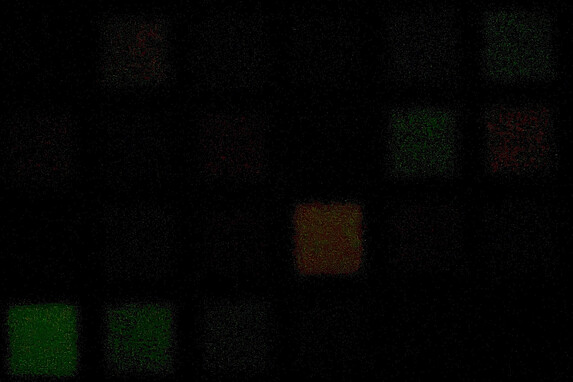
Accessories and Warranty - The fan isn't there anymore
The manufacturer offers a 24-month warranty for the Asus ROG Phone 6 or 6 Pro in Germany.
There is no difference in the included accessories, and the elaborately designed package of both smartphones includes a plastic case, a modular 65-Watt charger, and a USB-C cable. So the Pro model doesn't include the attachable AeroActive Cooler anymore, and it has to be purchased separately.
The new AeroActive Cooler 6 is significantly larger than its predecessor. Besides the cooling function, with its four additional control keys and foldable stand, it offers an additional value but can also get fairly loud at up to 45 dB (A). However, in contrast to the internal fan of the RedMagic 7, the fan here doesn't produce a similar high-frequency noise, so it won't be as annoying.
Asus also offers additional accessories, including attachable controllers, a full docking station, and more.
Input Devices and Operation - 720 Hz touch sampling rate in the ROG Phone 6
A fast touchscreen is of essential significance for a gaming smartphone, so Asus increased the touch sampling rate to 720 Hz and promises an extremely small response delay. The sliding characteristics of the Corning Gorilla Glass Victus surface are excellent, hardly offering any resistance to the fingers. The two additional ultrasound keys (AirTrigger 6) on the right side can replace some of the onscreen controls, causing the hands to cover less of the display surface.
For biometric security, an optical fingerprint sensor is housed underneath the display. It offers very good recognition rates and unlocks the Asus ROG Phone 6 (Pro) quickly. The same is also the case for the additional or alternative option of face recognition, but this is less secure.
With the Asus BackTap, there is an additional sensor area at the back, allowing you to execute additional commands such as creating a screenshot or opening the camera app. The integrated screen recorder offers recordings in 1080p at up to 120 FPS.
Display - Superbright AMOLED at up to 165 Hz
In terms of the form factor and resolution, the 6.78-inch AMOLED display is identical to that of the predecessor. However, Asus has increased the brightness noticeably. Both the ROG Phone 6 and 6 Pro, which use the same panel, reach 868 cd/m² on average with a pure white display. But this is only possible when the brightness sensor is activated, and if you adjust the brightness manually, it can still reach up to 549 cd/m². The peak brightness is reached with an even distribution of light and dark areas (APL18), rising up to 1,321 cd/m², which is about 300 cd/m² brighter than the ROG Phone 5s and optimally suited for the display of HDR content.
The refresh rate can rise up to 165 Hz. However, this is not an LTPO panel, so that the smallest possible refresh rate is at 60 Hz. When the automatic control is active, the system switches between 60 and 120 Hz. Only with the X mode, this is increased to 144 or 165 Hz. Alternatively, the desired refresh rate can also be adjusted manually in the settings.
The Asus ROG Phone 6 (Pro) is also not spared the OLED typical flickering. At minimal display brightness - which by the way turns out relatively high - the display flickers fairly irregularly between 220.2 and 672.1 Hz. These irregular variations can lead to some difficulties for sensitive users. Only from a panel brightness above 150 cd/m² (73%), we measure a constant 165 Hz. Optionally, a DC dimming mode is also available, but it only works at 60 Hz.
| |||||||||||||||||||||||||
Brightness Distribution: 97 %
Center on Battery: 860 cd/m²
Contrast: ∞:1 (Black: 0 cd/m²)
ΔE ColorChecker Calman: 2.4 | ∀{0.5-29.43 Ø4.77}
ΔE Greyscale Calman: 2.5 | ∀{0.09-98 Ø5}
100% sRGB (Calman 2D)
Gamma: 2.08
CCT: 6640 K
| Asus ROG Phone 6 Pro AMOLED, 2448x1080, 6.8" | Asus ROG Phone 5s AMOLED, 2448x1080, 6.8" | Xiaomi Black Shark 5 Pro AMOLED, 2400x1080, 6.7" | Nubia RedMagic 7 AMOLED, 2400x1080, 6.8" | |
|---|---|---|---|---|
| Screen | 12% | -44% | -44% | |
| Brightness middle (cd/m²) | 860 | 749 -13% | 642 -25% | 683 -21% |
| Brightness (cd/m²) | 868 | 750 -14% | 637 -27% | 685 -21% |
| Brightness Distribution (%) | 97 | 97 0% | 96 -1% | 95 -2% |
| Black Level * (cd/m²) | ||||
| Colorchecker dE 2000 * | 2.4 | 1.4 42% | 3.19 -33% | 3.6 -50% |
| Colorchecker dE 2000 max. * | 3.9 | 2.8 28% | 7.12 -83% | 6.7 -72% |
| Greyscale dE 2000 * | 2.5 | 1.8 28% | 4.9 -96% | 5 -100% |
| Gamma | 2.08 106% | 2.29 96% | 2.22 99% | 2.14 103% |
| CCT | 6640 98% | 6602 98% | 7671 85% | 7537 86% |
* ... smaller is better
Screen Flickering / PWM (Pulse-Width Modulation)
| Screen flickering / PWM detected | 672.1 Hz | ||
The display backlight flickers at 672.1 Hz (worst case, e.g., utilizing PWM) . The frequency of 672.1 Hz is quite high, so most users sensitive to PWM should not notice any flickering. In comparison: 53 % of all tested devices do not use PWM to dim the display. If PWM was detected, an average of 8077 (minimum: 5 - maximum: 343500) Hz was measured. | |||
Series of measurements with a fixed zoom level and various brightness settings
In the analysis with CalMAN, the Asus ROG Phone 6 shows a fairly cool color reproduction in the state of delivery. Those who prefer a more natural color reproduction can get this by selecting the Natural profile and Warm white balance.
Display Response Times
| ↔ Response Time Black to White | ||
|---|---|---|
| 0.998 ms ... rise ↗ and fall ↘ combined | ↗ 0.4794 ms rise | |
| ↘ 0.5186 ms fall | ||
| The screen shows very fast response rates in our tests and should be very well suited for fast-paced gaming. In comparison, all tested devices range from 0.1 (minimum) to 240 (maximum) ms. » 3 % of all devices are better. This means that the measured response time is better than the average of all tested devices (20.2 ms). | ||
| ↔ Response Time 50% Grey to 80% Grey | ||
| 1.042 ms ... rise ↗ and fall ↘ combined | ↗ 0.5158 ms rise | |
| ↘ 0.5258 ms fall | ||
| The screen shows very fast response rates in our tests and should be very well suited for fast-paced gaming. In comparison, all tested devices range from 0.165 (minimum) to 636 (maximum) ms. » 4 % of all devices are better. This means that the measured response time is better than the average of all tested devices (31.6 ms). | ||
Outdoors, the smartphones of the ROG 6 series offer a good readability, even possessing sufficient reserves for bright summer days. However, sometimes the brightness sensor takes a moment to respond to a new lighting situation.
The viewing angle stability of the Asus smartphones is very good, and from steep viewing angles, only the brightness is slightly reduced.
Performance - Snapdragon 8+ Gen 1 in the ROG Phone 6
The smartphones of the ROG Phone 6 series are all run by the Snapdragon 8+ Gen 1. On the other hand, the RAM equipment varies depending on the model, ranging through 12, 16, and 18 GB of working memory, with the latter reserved for the Pro model. But unfortunately, we did not see an advantage in the benchmarks resulting from the larger amount of memory.
While the performance increases in terms of CPU speed remain within limits, the new SoC is about 20% faster in AI computations compared to its Snapdragon 8 Gen 1 predecessor. However, Qualcomm has also changed only little in the CPU, only increasing the clock speed of the Prime cores by about 200 MHz.
| AImark - Score v2.x | |
| Asus ROG Phone 6 Pro | |
| Average Qualcomm Snapdragon 8+ Gen 1 (1043 - 7865, n=11) | |
| Asus ROG Phone 6 | |
| Oppo Find X5 Pro | |
| UL Procyon AI Inference for Android - Overall Score NNAPI | |
| Asus ROG Phone 6 Pro | |
| Asus ROG Phone 6 | |
| Oppo Find X5 Pro | |
| Average Qualcomm Snapdragon 8+ Gen 1 (3291 - 84787, n=21) | |
| Average of class Smartphone (3769 - 81594, n=136, last 2 years) | |
Nominally, the Adreno 730 is already used in the Snapdragon 8 Gen 1, but in the Plus model, its clock speed is supposed to be 10% higher. This is also confirmed by our benchmarks, which show increases between 8 and 11%.
However, it is interesting that the ROG Phone 6 Pro only reaches lower frame rates in the GFXBench tests than it should, placing significantly behind the Phone 6. One reason for this might be the additional two Gigabytes of working memory, since the SoC nominally only supports up to 16 GB of RAM.
GFXBench (DX / GLBenchmark) 2.7: T-Rex Onscreen | 1920x1080 T-Rex Offscreen
GFXBench 3.0: on screen Manhattan Onscreen OGL | 1920x1080 1080p Manhattan Offscreen
GFXBench 3.1: on screen Manhattan ES 3.1 Onscreen | 1920x1080 Manhattan ES 3.1 Offscreen
GFXBench: on screen Car Chase Onscreen | 1920x1080 Car Chase Offscreen | on screen Aztec Ruins High Tier Onscreen | 2560x1440 Aztec Ruins High Tier Offscreen | on screen Aztec Ruins Normal Tier Onscreen | 1920x1080 Aztec Ruins Normal Tier Offscreen
| 3DMark / Wild Life Extreme Unlimited | |
| Asus ROG Phone 6 Pro | |
| Asus ROG Phone 6 | |
| Nubia RedMagic 7 | |
| Xiaomi Black Shark 5 Pro | |
| Oppo Find X5 Pro | |
| Asus ROG Phone 5s | |
| 3DMark / Wild Life Extreme | |
| Asus ROG Phone 6 Pro | |
| Asus ROG Phone 6 | |
| Xiaomi Black Shark 5 Pro | |
| Nubia RedMagic 7 | |
| Oppo Find X5 Pro | |
| Asus ROG Phone 5s | |
| 3DMark / Wild Life Unlimited Score | |
| Asus ROG Phone 6 Pro | |
| Asus ROG Phone 6 | |
| Xiaomi Black Shark 5 Pro | |
| Nubia RedMagic 7 | |
| Oppo Find X5 Pro | |
| Asus ROG Phone 5s | |
| 3DMark / Wild Life Score | |
| Nubia RedMagic 7 | |
| Oppo Find X5 Pro | |
| Asus ROG Phone 5s | |
| Asus ROG Phone 6 | |
| Asus ROG Phone 6 Pro | |
| 3DMark / Sling Shot Extreme (ES 3.1) Unlimited Physics | |
| Asus ROG Phone 5s | |
| Asus ROG Phone 6 | |
| Nubia RedMagic 7 | |
| Asus ROG Phone 6 Pro | |
| Oppo Find X5 Pro | |
| 3DMark / Sling Shot Extreme (ES 3.1) Unlimited Graphics | |
| Asus ROG Phone 6 Pro | |
| Asus ROG Phone 6 | |
| Nubia RedMagic 7 | |
| Oppo Find X5 Pro | |
| Asus ROG Phone 5s | |
| 3DMark / Sling Shot Extreme (ES 3.1) Unlimited | |
| Asus ROG Phone 6 Pro | |
| Asus ROG Phone 6 | |
| Nubia RedMagic 7 | |
| Oppo Find X5 Pro | |
| Asus ROG Phone 5s | |
| 3DMark / Sling Shot OpenGL ES 3.0 Unlimited | |
| Asus ROG Phone 6 Pro | |
| Asus ROG Phone 6 | |
| Nubia RedMagic 7 | |
| Oppo Find X5 Pro | |
| Asus ROG Phone 5s | |
| 3DMark / Sling Shot OpenGL ES 3.0 Unlimited Graphics | |
| Asus ROG Phone 6 Pro | |
| Asus ROG Phone 6 | |
| Nubia RedMagic 7 | |
| Oppo Find X5 Pro | |
| Asus ROG Phone 5s | |
| 3DMark / Sling Shot OpenGL ES 3.0 Unlimited Physics | |
| Asus ROG Phone 5s | |
| Nubia RedMagic 7 | |
| Asus ROG Phone 6 Pro | |
| Asus ROG Phone 6 | |
| Oppo Find X5 Pro | |
| GFXBench (DX / GLBenchmark) 2.7 / T-Rex Onscreen | |
| Asus ROG Phone 6 | |
| Asus ROG Phone 6 Pro | |
| Oppo Find X5 Pro | |
| GFXBench (DX / GLBenchmark) 2.7 / T-Rex Offscreen | |
| Oppo Find X5 Pro | |
| Asus ROG Phone 6 Pro | |
| Asus ROG Phone 6 | |
| GFXBench 3.0 / Manhattan Onscreen OGL | |
| Asus ROG Phone 6 | |
| Asus ROG Phone 6 Pro | |
| Oppo Find X5 Pro | |
| GFXBench 3.0 / 1080p Manhattan Offscreen | |
| Asus ROG Phone 6 | |
| Asus ROG Phone 6 Pro | |
| Oppo Find X5 Pro | |
| GFXBench 3.1 / Manhattan ES 3.1 Onscreen | |
| Asus ROG Phone 6 | |
| Asus ROG Phone 6 Pro | |
| Oppo Find X5 Pro | |
| GFXBench 3.1 / Manhattan ES 3.1 Offscreen | |
| Asus ROG Phone 6 | |
| Asus ROG Phone 6 Pro | |
| Oppo Find X5 Pro | |
| GFXBench / Car Chase Onscreen | |
| Asus ROG Phone 6 | |
| Asus ROG Phone 6 Pro | |
| Oppo Find X5 Pro | |
| GFXBench / Car Chase Offscreen | |
| Asus ROG Phone 6 | |
| Asus ROG Phone 6 Pro | |
| Oppo Find X5 Pro | |
| GFXBench / Aztec Ruins High Tier Onscreen | |
| Asus ROG Phone 6 | |
| Asus ROG Phone 6 Pro | |
| Nubia RedMagic 7 | |
| Xiaomi Black Shark 5 Pro | |
| Asus ROG Phone 5s | |
| Oppo Find X5 Pro | |
| GFXBench / Aztec Ruins High Tier Offscreen | |
| Asus ROG Phone 6 | |
| Nubia RedMagic 7 | |
| Oppo Find X5 Pro | |
| Asus ROG Phone 6 Pro | |
| Asus ROG Phone 5s | |
| Xiaomi Black Shark 5 Pro | |
| GFXBench / Aztec Ruins Normal Tier Onscreen | |
| Asus ROG Phone 6 | |
| Nubia RedMagic 7 | |
| Asus ROG Phone 6 Pro | |
| Asus ROG Phone 5s | |
| Oppo Find X5 Pro | |
| Xiaomi Black Shark 5 Pro | |
| GFXBench / Aztec Ruins Normal Tier Offscreen | |
| Asus ROG Phone 6 | |
| Nubia RedMagic 7 | |
| Asus ROG Phone 6 Pro | |
| Oppo Find X5 Pro | |
| Asus ROG Phone 5s | |
| Xiaomi Black Shark 5 Pro | |
| Jetstream 2 - 2.0 Total Score | |
| Average of class Smartphone (23.8 - 387, n=149, last 2 years) | |
| Asus ROG Phone 6 Pro (Chrome 103) | |
| Asus ROG Phone 6 (Chrome 103) | |
| Average Qualcomm Snapdragon 8+ Gen 1 (76.2 - 204, n=23) | |
| Oppo Find X5 Pro (Chrome 99) | |
| Speedometer 2.0 - Result 2.0 | |
| Average of class Smartphone (15.2 - 643, n=121, last 2 years) | |
| Asus ROG Phone 6 (Chrome 103) | |
| Asus ROG Phone 6 Pro (Chrome 103) | |
| Average Qualcomm Snapdragon 8+ Gen 1 (69.1 - 196, n=18) | |
| Oppo Find X5 Pro (Chrome 99) | |
| Octane V2 - Total Score | |
| Asus ROG Phone 6 Pro (Chrome 103) | |
| Asus ROG Phone 6 (Chrome 103) | |
| Average of class Smartphone (2228 - 126661, n=197, last 2 years) | |
| Average Qualcomm Snapdragon 8+ Gen 1 (17622 - 61536, n=24) | |
| Oppo Find X5 Pro (Chrome 99) | |
| Mozilla Kraken 1.1 - Total | |
| Average of class Smartphone (257 - 28190, n=157, last 2 years) | |
| Oppo Find X5 Pro (Chrome 99) | |
| Average Qualcomm Snapdragon 8+ Gen 1 (665 - 1707, n=22) | |
| Asus ROG Phone 6 Pro (Chrome 103) | |
| Asus ROG Phone 6 (Chrome 103) | |
| WebXPRT 3 - Overall | |
| Asus ROG Phone 6 Pro (Chrome 103) | |
| Asus ROG Phone 6 (Chrome 103) | |
| Average of class Smartphone (38 - 380, n=30, last 2 years) | |
| Average Qualcomm Snapdragon 8+ Gen 1 (106 - 224, n=14) | |
| Oppo Find X5 Pro (Chrome 99) | |
| WebXPRT 4 - Overall | |
| Average of class Smartphone (27 - 306, n=145, last 2 years) | |
| Asus ROG Phone 6 Pro (Chrome 103) | |
| Asus ROG Phone 6 (Chrome 103) | |
| Average Qualcomm Snapdragon 8+ Gen 1 (69 - 159, n=21) | |
| Sunspider - 1.0 Total Score | |
| Asus ROG Phone 6 Pro | |
| Average Qualcomm Snapdragon 8+ Gen 1 (n=1) | |
| Average of class Smartphone (n=1last 2 years) | |
* ... smaller is better
| Asus ROG Phone 6 Pro | Asus ROG Phone 5s | Xiaomi Black Shark 5 Pro | Nubia RedMagic 7 | Average 512 GB UFS 3.1 Flash | Average of class Smartphone | |
|---|---|---|---|---|---|---|
| AndroBench 3-5 | -21% | 3% | -15% | -9% | 5% | |
| Sequential Read 256KB (MB/s) | 1949.16 | 1972 1% | 1945.4 0% | 1750 -10% | 1874 ? -4% | 2242 ? 15% |
| Sequential Write 256KB (MB/s) | 1454.5 | 770 -47% | 1485.2 2% | 1260 -13% | 1338 ? -8% | 1881 ? 29% |
| Random Read 4KB (MB/s) | 297.48 | 297.8 0% | 344.9 16% | 306.2 3% | 290 ? -3% | 299 ? 1% |
| Random Write 4KB (MB/s) | 459.66 | 287.2 -38% | 424.8 -8% | 282.5 -39% | 357 ? -22% | 345 ? -25% |
Games - Asus unleashes the gaming beast
We evaluate the gaming characteristics of the Asus ROG Phone 6 (Pro) using GameBench, without adding the external fan. However, the gaming smartphone still doesn't show any weaknesses under constant load and doesn't demand any compromises between performance and display quality.
In contrast to the predecessor, we are unable to tease out the full frame rates in all games. For example, after a system update we don't have the 90 FPS in PUBG at the lowest graphics level anymore, but only 60 FPS. Similarly, in Armajet the Asus smartphone also could not be convinced to display more than 30 FPS. But Asus will surely still provide some improvements here in the future.
Emissions - The ROG Phone 6 likes it hot and noisy
Temperatures
The surface temperatures of the Asus ROG Phone 6 and 6 Pro are slightly elevated in idle operation, but then they hardly increase under some load. However, this looks different under heavy load such as in the stress test of the 3DMark where we measure some top values of up to 50 °C (122 °) in the frame. But with the help of the fan, the surface can also be cooled correspondingly.
Asus has placed the Snapdragon 8+ Gen 1 in the center of the case in order to be able to place the optional AeroActive cooler right above it. In the 3DMark stress test, not only does this result in cooler fingers, but also in absolutely stable frame rates. But even without the additional cooling fan, the cooling concept of the ROG smartphone is sufficient to maintain the long term performance for a relatively long time. In the long run, the ROG Phone 6 is even faster than the iPhone 13 Pro.
(+) The maximum temperature on the upper side is 37 °C / 99 F, compared to the average of 35.2 °C / 95 F, ranging from 21.9 to 247 °C for the class Smartphone.
(+) The bottom heats up to a maximum of 35.4 °C / 96 F, compared to the average of 34 °C / 93 F
(±) In idle usage, the average temperature for the upper side is 32.8 °C / 91 F, compared to the device average of 32.9 °C / 91 F.
3DMark Wild Life Stress Test
| 3DMark | |
| Wild Life Stress Test Stability | |
| Asus ROG Phone 6 Pro | |
| Asus ROG Phone 5s | |
| Nubia RedMagic 7 | |
| Nubia RedMagic 7 | |
| Asus ROG Phone 6 | |
| Wild Life Extreme Stress Test | |
| Asus ROG Phone 6 Pro | |
| Asus ROG Phone 6 | |
| Nubia RedMagic 7 | |
| Asus ROG Phone 5s | |
Speakers
The sound of the Asus ROG Phone 6 is impressive. It offers two really good speakers that not only can get very loud but also deliver a surprising amount of bass.
The integrated audio port is one of the best we have seen in a smartphone so far. It shows itself in our test as absolutely free of noise (SNR: 110,62 dBFS). Those who prefer wireless headphones or speakers can take advantage of all the usual audio codecs via Bluetooth (SBC, AAC, aptX, aptX HD, aptX Adaptive, aptX TWS+, LDAC).
Asus ROG Phone 6 Pro audio analysis
(+) | speakers can play relatively loud (93.3 dB)
Bass 100 - 315 Hz
(-) | nearly no bass - on average 22.6% lower than median
(+) | bass is linear (3.9% delta to prev. frequency)
Mids 400 - 2000 Hz
(+) | balanced mids - only 4.7% away from median
(+) | mids are linear (3.9% delta to prev. frequency)
Highs 2 - 16 kHz
(+) | balanced highs - only 2.7% away from median
(+) | highs are linear (3.2% delta to prev. frequency)
Overall 100 - 16.000 Hz
(±) | linearity of overall sound is average (15.5% difference to median)
Compared to same class
» 4% of all tested devices in this class were better, 3% similar, 93% worse
» The best had a delta of 11%, average was 35%, worst was 134%
Compared to all devices tested
» 22% of all tested devices were better, 4% similar, 74% worse
» The best had a delta of 4%, average was 24%, worst was 134%
Xiaomi Black Shark 5 Pro audio analysis
(+) | speakers can play relatively loud (86.2 dB)
Bass 100 - 315 Hz
(-) | nearly no bass - on average 20% lower than median
(±) | linearity of bass is average (8.4% delta to prev. frequency)
Mids 400 - 2000 Hz
(±) | higher mids - on average 5.6% higher than median
(+) | mids are linear (4.6% delta to prev. frequency)
Highs 2 - 16 kHz
(+) | balanced highs - only 3.1% away from median
(+) | highs are linear (2.8% delta to prev. frequency)
Overall 100 - 16.000 Hz
(±) | linearity of overall sound is average (16.3% difference to median)
Compared to same class
» 6% of all tested devices in this class were better, 5% similar, 89% worse
» The best had a delta of 11%, average was 35%, worst was 134%
Compared to all devices tested
» 26% of all tested devices were better, 6% similar, 68% worse
» The best had a delta of 4%, average was 24%, worst was 134%
Battery Life - 6,000 mAh for a long runtime
Power Consumption
The power consumption of the Asus ROG Phone 6 Pro is inconspicuous and very low, particularly during idle operation.
In the tests with adjusted display brightness, it shows a similar power consumption as the predecessor, despite its higher performance.
| Off / Standby | |
| Idle | |
| Load |
|
Key:
min: | |
Power Consumption: Geekbench (150 cd/m²)
Power Consumption: GFXBench (150 cd/m²)
Battery Life
We tested the battery life of the Asus smartphones with a display brightness of 150 cd/m². While we ran the Asus ROG Phone 6 Pro with a fixed refresh rate of 60 Hz and DC dimming, the ROG Phone 6 ran at 165 Hz.
The batteries (2 x 3000 mAh) of the Pro model last almost 2 hours longer, if we don't use the increased refresh rate. However, we also need to mention that the 16 hours of the ROG Phone 6 also represent an excellent result.
| Battery Runtime - WiFi Websurfing | |
| Asus ROG Phone 6 Pro | |
| Asus ROG Phone 6 | |
| Xiaomi Black Shark 5 Pro | |
| Asus ROG Phone 5s | |
| Nubia RedMagic 7 | |
Pros
Cons
Verdict - The Asus gamer gets even better
The ROG Phone 6 series presents itself as a successful and well-thought-out advancement of its predecessor. Asus has again succeeded in managing the top SoC from Qualcomm even without an active cooling system. With the attachable AeroActive cooler, there is an option that allows you to use the Snapdragon 8+ Gen 1 almost without any loss in performance.
Again included are the AirTrigger ultrasound sensors. The display has not only become brighter, but now also offers a refresh rate of up to 165 Hz as well as a touch sampling rate of 720 Hz. In addition, the camera setup was improved with a new main sensor that is also used in other flagship smartphones.
The Asus ROG Phone 6 and 6 Pro create some enthusiasm in the hearts of those gamers who don't like to compromise.
However, the model selection is at least questionable. The differences between the ROG Phone 6 and the Pro version are not particularly large. The latter only offers an additional 2 GB of RAM, the PMOLED display on the back, and a few more mobile communication frequencies. But our test has shown that the additional working memory doesn't bring any advantages. So those who don't necessarily need to have the PMOLED display can also safely choose one of the two non-Pro models.
Strong alternatives are the Black Shark 5 Pro and the RedMagic 7. The latter even offers an integrated fan. An affordable alternative is the Poco F4 GT, but you then have to make some compromises in all regards.
Price and Availability
All the configurations of the Asus ROG Phone 6 smartphones are listed in the Asus online shop (price currently not listed), and you can also purchase them from Amazon, for example.
Asus ROG Phone 6 Pro
- 08/30/2022 v7 (old)
Daniel Schmidt


